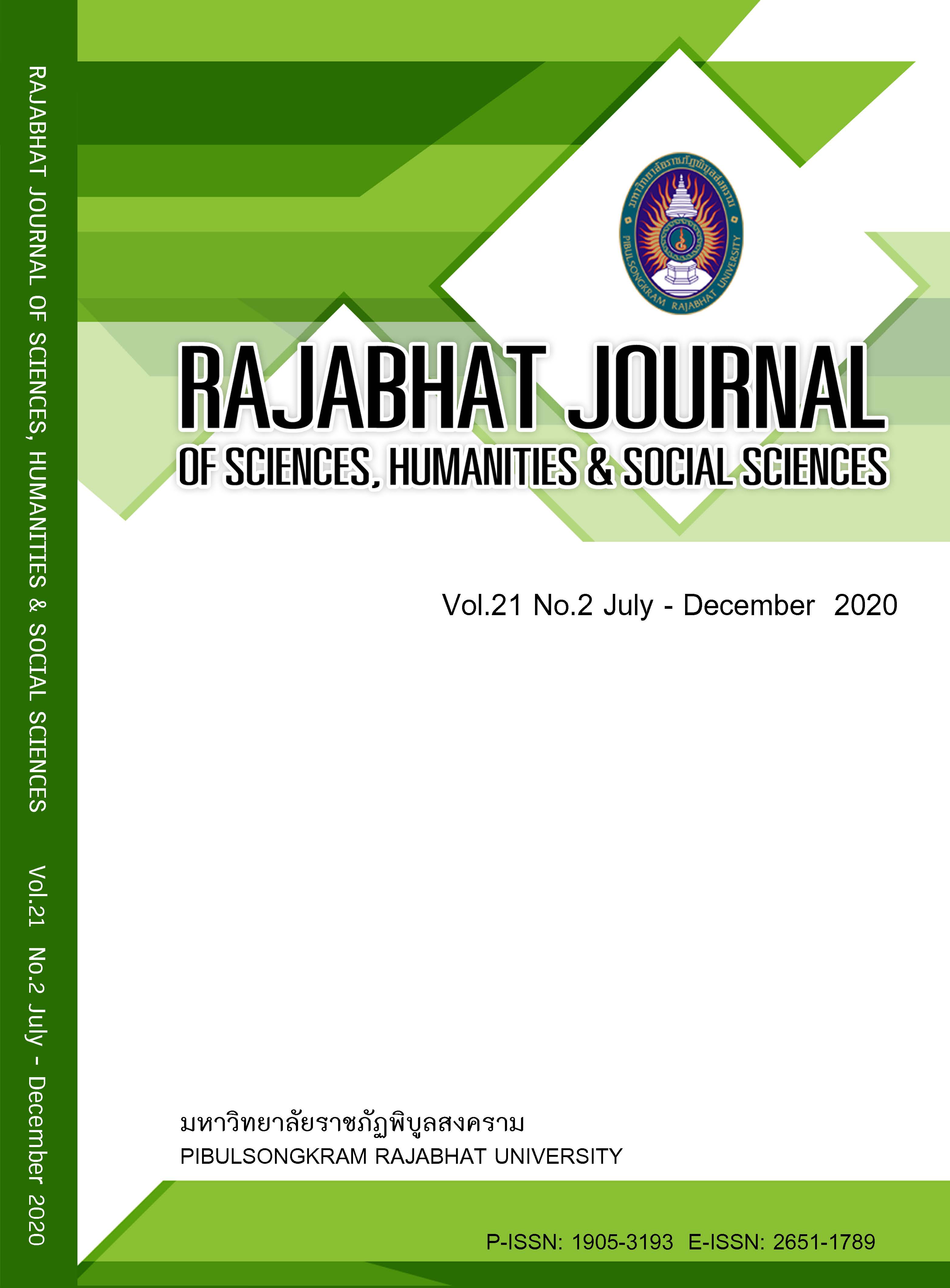PHYLOGENETIC AND IDENTIFICATION OF PHITSANULOK’S LANDRACE RICE BASED ON NUCLEOTIDE SEQUENCE ANALYSIS OF TRNH-PSBA
Keywords:
Landrace rice, Phitsanulok, Identification, DNA barcode, trnH-psbAAbstract
Landrace rice identification is generally based on morphological characters, which is costly, labor-intensive including time-consuming process. This study was aimed to improve the identification of Phitsanulok’s Landrace rice assay using DNA barcoding based on nucleotide sequence diversity at trnH-psbA locus. The PCR product was amplified corresponding to ~650 bp long which could classify Phitsanulok’s landrace rice into 2 groups. Ton Dip and Lao is the farthest evolution from the ancestor. Individual sequence among 35 landrace-rice cultivars had a high genetic divergence (%K2P) approximately 19%, compared to Oryza sativa L. and 1.3% within group of the Phitsanulok’s landrace rice. Thirty out of Phitsanulok’s landrace rice cultivated varieties was able to be identified by using DNA barcode at trnH-psbA locus with the high efficient of 85.71%. This finding is the first report of implemented DNA barcode at trnH-psbA locus to identify Thai landrace rice’s subspecies using trnH-psbA DNA barcode . However, the combinations of more two DNA barcodes with different loci would be further experimental for increasing efficiency of identification in landrace rice cultivated varieties.
References
Aiumsumang S, Phimphan S. Assessment of genetic relationship of rice using SSR markers. Khon Kaen Agriculture Journal. 2019; 47(1): 603-610.
Aiumsumang S, Srisuvoramas B, Koomsab K. Genetic relationship of some rice varieties in Phetchabun province using nucleotide sequence of rbcl genes. Journal of Science & Technology Phetchabun Rajabhat University. 2018; 3(1): 32-39.
Chase MW, Cowan RS, Hollingsworth PM. et al. A proposal for a standardised protocol to barcode all land plants. Taxon. 2007; 56: 295-299.
Costion C, Ford A, Cross H. et al. Plant DNA barcodes can accurately estimate species richness in poorly known floras. PLoS ONE. 2011; 6(11): e26841.
Hollingsworth PM. DNA barcoding plants in biodiversity hot spots: Progress and outstanding questions. Heredity. 2008; 101(1): 1-2.
Kim HM, Oh SH, Bhandari GS. et al. DNA barcoding of Orchidaceae in Korea. Molecular Ecology Resources. 2014; 14: 499–507.
Kress WJ, Erickson DL. A two-locus global DNA barcode for land plants: the coding rbcL gene complements the non-coding trnH-psbA spacer region. PLoS ONE. 2007; 2: e508.
Kress WJ, Wurdack KJ, Zimmer EA. et al. Use of DNA barcodes to identify flowering plants. Proceedings of the National Academy of Sciences. 2005; 102: 8369-8374.
Kumar S, Stecher G, Li M. et al. MEGA X: Molecular evolutionary genetics analysis across computing platforms. Molecular Biology and Evolution. 2018; 35: 1547-1549.
Ladpala S, Boonkorn P, Thaisuchat H. Genetic diversity of black sticky rice in Lampang province by RAPD technique. Khon Kaen Agriculture Journal. 2018; 46(1): 468-474.
Lahaye R, van der Bank M, Bogarin D. et al. DNA barcoding the floras of biodiversity hotspots. Proceedings of the National Academy of Sciences. 2008; 105(8): 2923-2928.
Liu Z, Zeng X, Yang D. et al. Applying DNA barcodes for identification of plant species in the family Araliaceae. Gene. 2012; 499: 76–80.
Ma X, Xie C, Liu C. et al. Species identification of medicinal pterdophytes by a DNA barcode marker, the chloroplast psbA-trnH intergenic region. Biological and Pharmaceutical Bulletin. 2010; 33: 1919–1924.
Maneenet T, Thanananta T, Thanananta N. Assessment of genetic relationship and Identification of Dendrobium section callista using nucleotide sequences of rbcL gene and trnH-psbA intergenic spacer region. Thai Journal of Science and Technology. 2018; 7(2): 181-190.
Monkheang P, Chaveerach A, Tanee T. et al. DNA Barcode for Identification of Processed Medicinal Senna Species. KKU Research Journal (Graduate Studies). 2013; 13(2): 18-30.
Mullis K, Faloona F, Scharf S. Specific enzymatic amplification of DNA in vitro: The polymerase chain reaction. Cold Spring Harbor Symposia on Quantitative Biology. 1986; 51(1): 263-273.
Osathanunkul M, Ounja S, Osathanunku R. et al. Evaluation of a DNA-based method for spice/herb authentication, so you do not have to worry about what is in your curry, buon appetite. PLoS ONE. 2017; 12(10): e0186283.
Phosiri P, Sreewongchai T, Chowpongpang S. Genetic relationship analysis of rice using AFLP marker. Proceedings of The 54th Kasetsart University Annual Conference. 2017; 285-292.
Phungsombat W, Hutsadang K, Bodeerat SC. et al. The validation of DNA markers for landrace rice varieties discrimination. Proceeding of 12th Rajamangala University of Technology Tawan-ok Research Conference. 2019; 1101-1111.
Ribeiro PL, Rapini A, Silva UCS, Berg C. Using multiple analytical methods to improve phylogenetic hypotheses in Minaria (Apocynaceae). Molecular Phylogenetics and Evolution. 2012; 65(3): 915-925.
Sang T, Crawford DJ, Stuessy TF. Chloroplast DNA phylogeny, reticulate evolution and biogeography of Paeonia (Paeoniaceae). American Journal of Botany. 1997; 84: 1120-1136.
Soltis PS & Soltis DE. Applying the bootstrap in phylogeny reconstruction. Statistical Science. 2003; 18(2): 256–267.
Somjai O, Nualsri C, Laosuwan P. Genetic diversity of indigenous rice in Nathawi basin of Songkhla province by seed morphology and microsatellite markers. Agricultural Science Journal. 2010; 41(1): 89-97.
Tajima F & Nei M. Estimation of evolutionary distance between nucleotide sequences. Molecular Biology and Evolution. 1984; 1: 269-285.
Tamura K & Nei M. Estimation of the number of nucleotide substitutions in the control region of mitochondrial DNA in humans and chimpanzees. Molecular Biology and Evolution. 1993; 10: 512-526.
Tate JA, Simpson BB. Paraphyly of Tarasa (Malvaceae) and diverse origins of the polyploid species. Systematic Botany. 2003; 28: 723-737.
Techen N, Parveen I, Pan Z. et al. DNA barcoding of medicinal plant material for identification. Current Opinion in Biotechnology. 2014; 25C: 103-110.
Urtgam S & Jongjitvimol T. Landrace rice in Phitsanulok province. PSRU Journal of Science and Technology. 2019; 4(1): 19-27.
Waugh J. DNA barcoding in animal species: progress, potential and pitfalls. BioEssays. 2018; 29: 188–197.
Zuo Y, Chen C, Kondo K. et al. DNA barcoding of Panax species. Planta Medica. 2011; 77(2): 182-187.
Downloads
Published
How to Cite
Issue
Section
License
Each article is copyrighted © by its author(s) and is published under license from the author(s).










